The Best Sales Forecasting Software
Our picks showcase solutions that help accurately predict future revenue, expenses, and growth trends while minimizing human error. Review options tailored to different business needs, from small teams to large enterprises.
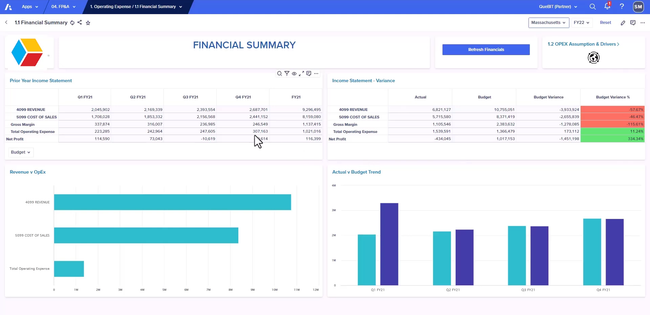
- Connected Planning platform enables collaborative planning
- Hyperblock™ modeling and calculation engine
- Unified cloud-based software
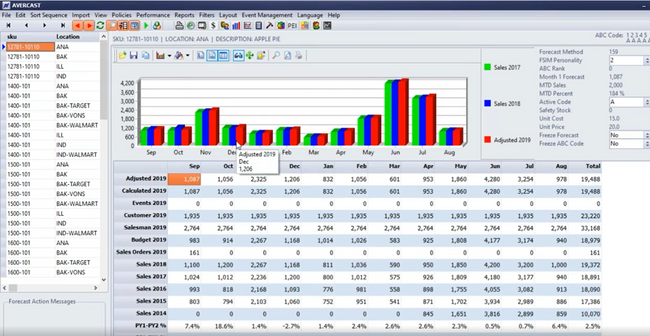
- Direct output to Excel
- Over 250 forecasting algorithms
- Integrates with SYSPRO, Microsoft Dynamics, etc.
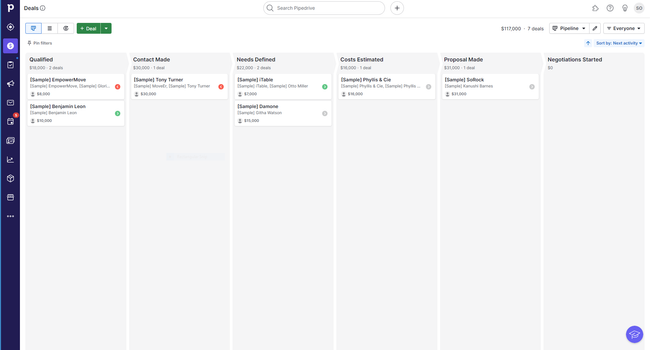
- Easy to set up
- Strong team collaboration features
- High customer support satisfaction
The right forecasting software will create financial reports of expected sales based on historical trends, economic conditions, industry behavior, changes within your company, and selected time periods.
- Anaplan: Best Overall
- Avercast: Best for Distribution
- Pipedrive: Most Customizable
- Workday Adaptive Planning: Best For Large Enterprises
Anaplan - Best Overall
Anaplan delivers a real-time, data-driven approach that makes it the go-to for any business looking to have a pulse on its sales metrics. Its cloud-based nature ensures remote teams’ accessibility.
What sets Anaplan apart is its flexibility in data manipulation. Users can zoom in on specifics like geography, SKU, or even a set of accounts to get an accurate forecast. This level of granularity enables sales teams to pivot strategies in real time, much like a weather app that updates every second.
Additionally, Anaplan offers a holistic view of sales metrics, ensuring that not just sales teams but also finance, marketing, and executive leaders are on the same page. Its integrative approach brings together various data points into a single dashboard, thereby fostering enhanced communication and decision-making across the board. Its scalable architecture means it’s not just limited to sales forecasting; you can add modules for workforce planning and supply chain management as your business grows.
Avercast - Best for Distribution
Avercast enhances sales forecasting through over 280 forecasting algorithms and AI-driven backcasting. By projecting customer buying patterns and sales trends, the system helps you stay on top of demand and minimize missed sales opportunities.
Avercast imports sales histories from your ERP system, like SYSPRO. Then, it applies all 280 forecasting algorithms to this data to pinpoint the most accurate forecast. The software continuously refines these predictions, and its AI adapts to changes by learning which algorithms perform best for certain sectors, regions, and even customer segments.
For wholesale distributors, Avercast’s algorithms also support order and shipment optimization. For example, based on predictive analytics, you can forward-pull likely purchases to ship full pallets of best-selling SKUs. This helps you avoid the risk of backorders, improves your shipping efficiency, and keeps your pipeline flowing smoothly.
This platform offers an entry-level, subscription-based plan starting at $1000/month, with scalable options for larger teams and complex operations. While some users find the interface somewhat dated, its integration with major ERP systems like Microsoft Dynamics makes it an accessible sales forecasting tool.
See our Avercast profile to learn more.
Pipedrive - Most Customizable
Pipedrive is ideal for small to midsize businesses. It offers custom dashboards to eliminate the need for manual spreadsheets and provides an interactive way to visualize important KPIs. From tracking customer churn rates to predicting cash flow with recurring revenue, Pipedrive offers a holistic toolset for forecasting, making it a top pick for businesses serious about leveraging data for growth.
Pipedrive features real-time reports and complete sales pipeline visibility, enabling sales teams to focus on activities and deals that will help meet targets. The platform’s metrics-based approach fuels decision-making, allowing for quick adjustments in strategy to ensure that sales objectives are met and exceeded.
Its CRM is equipped with powerful forecasting features, such as the ability to measure historical sales performance to tweak future offers and pricing. This data-driven methodology minimizes risks and enables accurate revenue prediction.
Workday Adaptive Planning - Best For Large Enterprises
Workday Adaptive Planning excels in sales forecasting, particularly for large enterprises looking to capture every slice of the market pie. Its real-time functionality allows for rapid adjustments to territories and quotas, crucial for big players dealing with multiple markets and products. With the capability to quickly model and distribute quotas, align sales resources to revenue targets, and integrate CRM data, it’s like having a command center that’s always ahead of the curve.
What sets it apart is its scalability and flexibility. Large enterprises often have to navigate complex planning needs, and Workday Adaptive Planning is built to handle that complexity without breaking a sweat. The software’s unified data core ensures that your sales plans are in sync with other departments like finance and HR, creating a streamlined, holistic strategy. It’s not just a tool; it’s an ecosystem that large enterprises can leverage for a comprehensive, data-driven approach to sales planning.
What is Sales Forecasting Software?
Sales forecasting software creates financial reports of expected sales based on historical trends, economic conditions, industry behavior, changes within your company, and selected time periods. An accurate forecast can provide the information your sales team needs to better understand and achieve sales goals.
Whether a small business or a large enterprise, forecasting tools help with tough decision-making. Sales forecasting software uses customizable templates to build visualizations of financial forecasts that can be adjusted at any time, letting you test out different “what if” scenarios. For example, something that negatively affects a sales process in the short term could have increasingly positive returns in the long term, and sales forecasting software will let your business predict those metrics.
There are a few distinct types of web-based sales forecasting software, such as quantitative and qualitative, which can make finding the right solution difficult. Things to consider in finding a system to provide an accurate forecast will be ease of use, affordability, and total functionality.
Key Features
- Demand Forecast: Forecast by item SKU or location on a monthly or weekly basis; Create statistical-based forecasts to analyze levels, seasonality, trends, and intermittency of products
- Financial Modeling: Generate graphs to create visualizations and simulations of your sales data
- Revenue Planning: Use automation to fill sales forecasts for your next periods; Import current sales prices and use historical data to align revenue forecasts with demand forecasts
- Approval System: Helps you see which forecasts have been viewed and approved and which need further attention
- Reporting: Create in-depth forecast accuracy reports based on key performance indicators (KPIs) and other select metrics to measure performance over time
- Import Capabilities: Integrate your forecasting solution with tools you use to record data, such as Excel, accounting software, or an ERP system
- Assumption Management: Planned promotions not reflected in historical data can be manually accounted for to ensure revenue planning and overall sales forecasts are accurate
- Collaboration: Encourage communication between sales reps; Add notes to reports, spreadsheets, and other planning items to document the forecasting process
- Sales Planning: Track the sales process in real-time, from the initial lead to the final invoice, to measure performance effectiveness of the pipeline
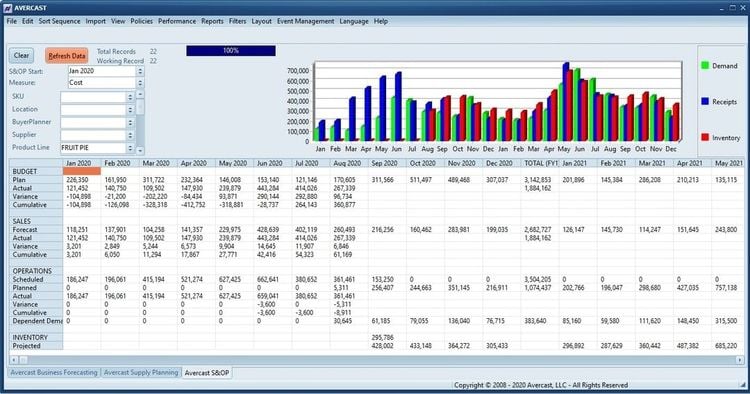
Types of Forecasting Software
Forecasting software comes in various flavors, each designed to tackle specific aspects of business operations and planning. Here’s a breakdown:
1 Financial Forecasting Software
Financial forecasting software focuses on projecting your company’s financial health, diving deep into revenue estimates, budgeting, and expenses. It’s a staple for finance teams but can also be a standalone feature within broader accounting software.
Key Functions:
- Revenue projection
- Expense planning
- Budget management
2 Sales Forecasting Software
Sales forecasting software uses historical sales data to set realistic sales targets, helping you adapt your marketing strategies like discounts or bundling. It’s not just for the sales team—supply chain folks use it to plan inventory and production.
Key Functions:
- Accurate sales targets
- Marketing strategy analysis
- Inventory planning
3 Demand Forecasting Software
Demand forecasting software zeroes in on consumer behavior and market trends, letting you adjust your inventory before demand peaks or valleys hit.
Key Functions:
- Consumer behavior tracking
- Seasonal demand planning
- Inventory optimization
4 Capacity and Workforce Forecasting Software
Capacity and workforce forecasting software integrates demand and sales projections to help you determine staffing levels, workflow, and even production capacity.
Key Functions:
- Staffing level optimization
- Workflow planning
- Production capacity planning
5 Enterprise Resource Planning (ERP) Software
The jack-of-all-trades, ERP software can do a bit of everything. It combines features of many other types of forecasting software into one platform but usually comes with a hefty price tag.
Key Functions:
- Centralized planning
- Comprehensive feature set
- High configurability
6 Specialized Forecasting Software
Specialized forecasting software targets unique needs like cash flow, revenue, or budget-specific forecasting.
- Cash Flow Forecasting Software: Gives you the play-by-play on money coming in and going out.
- Revenue Forecasting Software: Makes educated guesses on your future earnings based on past revenue.
- Budget Forecasting Software: Helps you sketch out your financial game plan by projecting future budgets.
Forecasting Methods
There are several different forecasting methods that software can cover, broadly defined as either quantitative (reviewing historical data) or qualitative (using recent data or expertise):
- Historical Sales Forecasting Software: A historical or quantitative sales forecasting software looks at previous performance of your company to determine a mean (or average) sales level you can expect for the following month, year, or whatever time period you’re looking at based on the seasonality of what is being sold.
- Surveyed Forecasting Software: This short-term qualitative forecasting method directly asks the customers what their intentions are for buying your product in the near future. Asking customers comes in the form of surveys or direct interaction with prospects themselves by the sales team.
- Pipeline or Opportunity Sales Forecasting Software: Blending qualitative and quantitative, pipeline sales forecasting software takes into account opportunities that already exist within your existing sales pipeline and helps determine a win rate to establish the priority they should be handled in. Look at the value of an opportunity (expected sale price), including the age of the opportunity and the sales personnel working the opportunity.
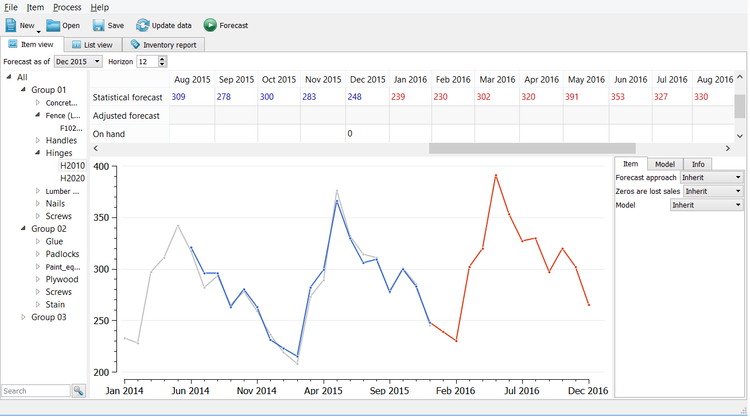
Sales Forecasting vs. Demand Planning Software
Demand planning software helps forecast demand for a product so it can be developed and shipped in as efficient of possible ways. It can also help you manage your overall sales and operations planning stage (S&OP). In sales forecasting, demand planning is the first step in calculating expectations of sales for a specific period. While demand planning helps gauge the interest of buyers and better assists in product development, sales forecasting provides the numbers for anticipated revenue.
Can Excel Work as a Sales Forecasting Software?
Excel can operate as a basic sales forecasting software by using historical time-based data and custom formulas. An Excel spreadsheet is often the first choice for many companies trying to create sales forecasts given its prevalence in the workplace. These forecasts can let your company get basic sale predictions, determine inventory requirements, or identify emerging consumer trends. However, using spreadsheets instead of an automated sales forecasting solution can leave you vulnerable to human error and simple mistakes.
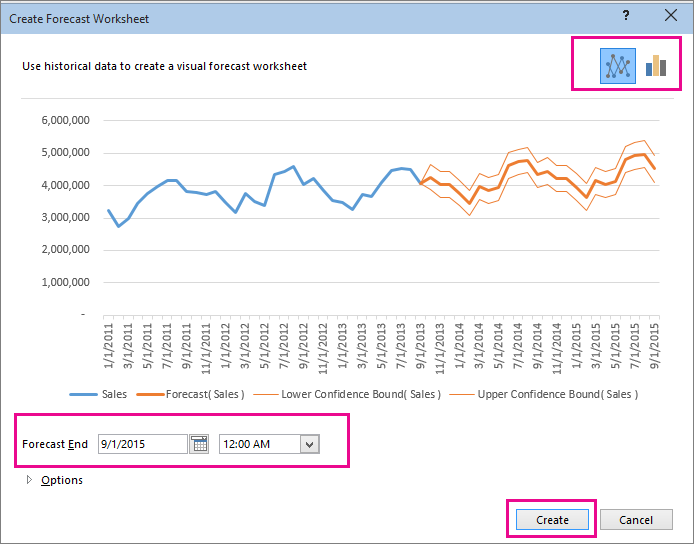
Selection Criteria
Here are the key criteria we used for recommending standout sales forecasting software:
Essential Features
- Real-Time Data Analytics: Real-time data analytics are essential for any large enterprise. The software should provide real-time updates on market trends, customer behavior, and sales performance.
- Quota and Territory Planning: Look for tools that allow you to set, distribute, and adjust sales quotas and territories. It should also offer features to align these metrics with revenue goals.
- Integration with CRM and Other Data Sources: Sales data often resides in CRM systems or other databases. Good sales forecasting software should be able to integrate seamlessly with these platforms, pulling in relevant data for more accurate forecasting.
- Scenario Modeling: The ability to create and compare various sales scenarios can provide invaluable insights. Make sure the software allows for “what-if” scenario planning to test the impact of different variables.
Advanced Features
AI and Machine Learning: Features that use AI and machine learning can offer predictive insights that go beyond traditional analytics, helping to anticipate market changes before they happen.
Industry Fit
Different industries have unique needs. Make sure the software you choose is versatile or specialized enough to handle your business sector’s specific demands.
Price vs Value
While cost is always a factor, the focus should be on the value the software delivers. Features like scalability, ease of use, and the quality of customer support are as critical as the price tag.
Cross-Functional Alignment
Large enterprises often have interconnected departments. Choose a platform that allows for alignment between sales forecasts and other business operations, such as HR and finance, to ensure a coherent business strategy.
Data Security
Strong security features are a must when processing sensitive sales data. Ensure the software complies with industry standards and regulations to protect your data.
Each of these criteria plays a significant role in determining the suitability of sales forecasting software for your enterprise’s needs. So, whether you’re aiming for real-time analytics, seamless integration, or scalability, keep these guidelines handy.


























